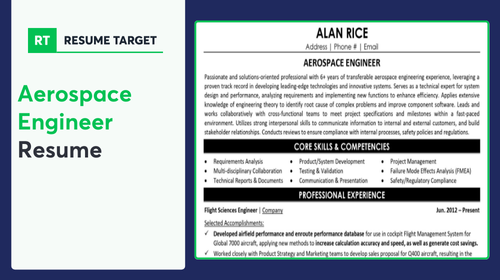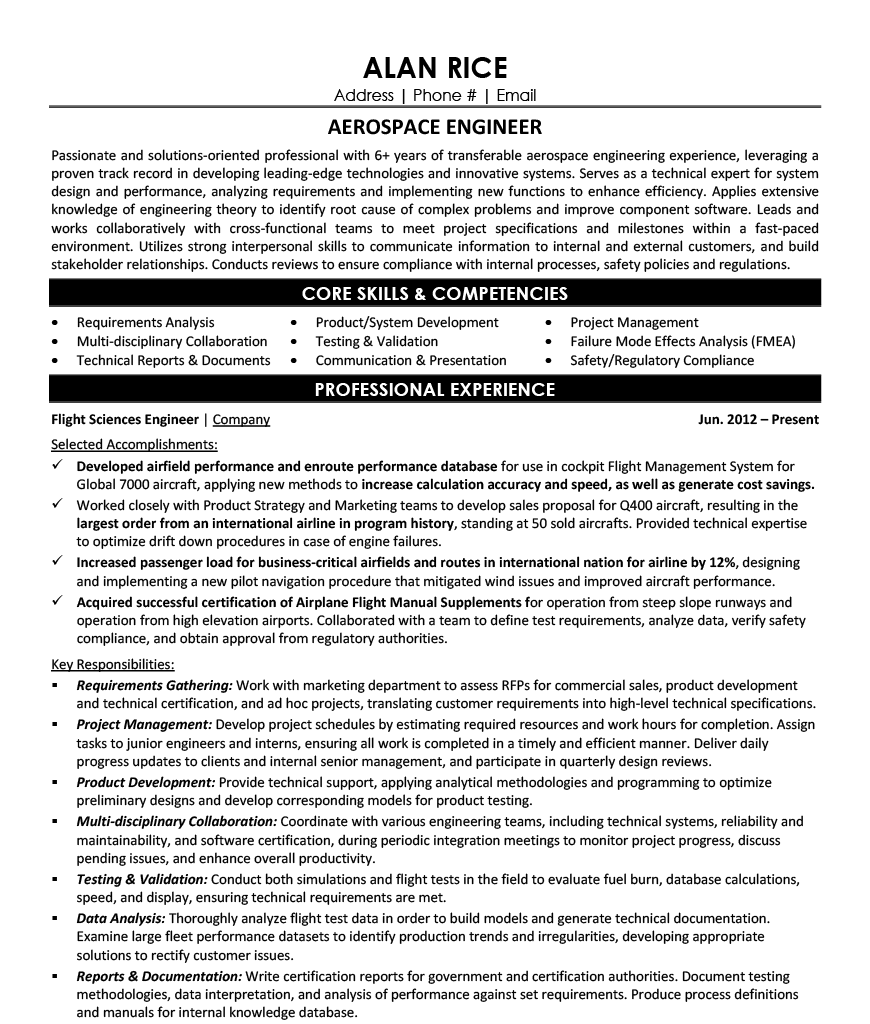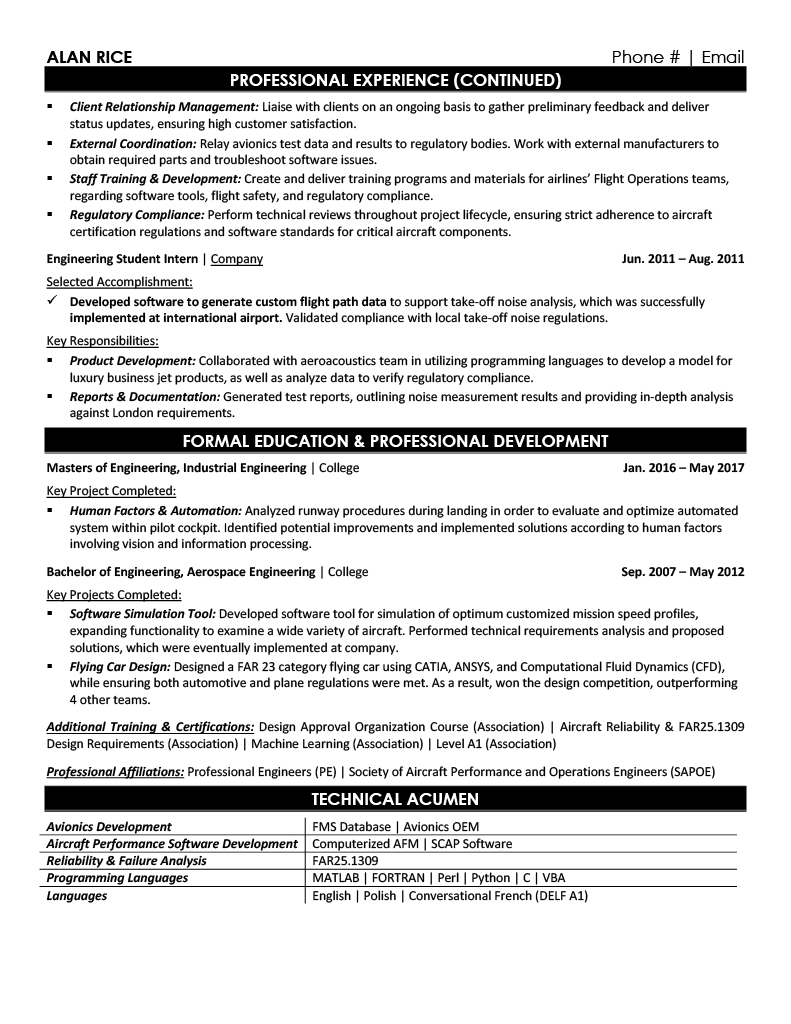

Complex technical skills and groundbreaking innovations don't always translate well to paper. Many aerospace engineers struggle to explain their achievements in a way hiring managers can quickly grasp.
Are your remarkable engineering accomplishments getting lost in translation on your resume? You need a clear way to showcase your technical expertise while highlighting the real-world impact of your work.
Resume Target specializes in helping aerospace engineers transform complex projects into compelling career stories. We'll help you create a resume that speaks both to technical recruiters and executive decision-makers, opening doors to your next breakthrough opportunity.


At the cutting edge of human flight and space exploration, aerospace engineers are the brilliant minds who transform ambitious dreams into soaring realities, designing everything from commercial jets to interplanetary spacecraft that can achieve speeds exceeding 17,000 miles per hour in orbit.
Your role as an aerospace engineer involves mastering complex physics principles, utilizing advanced computer-aided design software, and collaborating with multidisciplinary teams to develop aircraft and spacecraft that push the boundaries of what's possible while maintaining rigorous safety standards.
Whether you're passionate about aeronautical engineering for atmospheric flight or astronautical engineering for space exploration, this dynamic field offers numerous paths for growth, from specializing in propulsion systems to leading cutting-edge research in spacecraft design.
Let's talk about the exciting earning potential in aerospace engineering! Your career in this innovative field can take you from designing cutting-edge aircraft to developing spacecraft systems, with compensation that reflects your expertise and specialization. And guess what? The rewards are substantial - from entry-level positions to executive roles, your earning potential can more than double as you advance in your career.
Figures from: University of North Dakota
As an Aerospace Engineer, your career path can soar from entry-level positions to senior leadership roles. With experience and additional credentials, you can advance to technical specialist or management positions, shaping the future of aviation and space exploration.
To accelerate your aerospace engineering career, you'll need to master both technical expertise and essential soft skills that set you apart in this dynamic field.
Launch your aerospace engineering career by combining a bachelor's degree in aerospace engineering with hands-on experience through internships at major companies like Boeing, where entry-level opportunities await ambitious graduates.
To excel in aerospace engineering, you'll need to develop a strong foundation in analytical skills, math proficiency, and problem-solving abilities, which are essential for advancing in this dynamic field.
Requirements from Teal HQ
From California's aerospace hub to Texas' space centers, engineering opportunities soar across manufacturing and government.
Figures from U.S. Bureau of Labor Statistics
Struggling to translate your complex aerospace engineering projects, technical skills, and achievements into a clear, compelling resume that hiring managers will actually understand? This comprehensive, section-by-section guide will walk you through exactly how to showcase your engineering expertise, from propulsion systems to aircraft design, in a way that catches recruiters' attention.
As an aerospace engineer, you excel at solving complex technical challenges, yet condensing your impressive career into a few powerful sentences can feel more daunting than designing flight control systems.
While you may be comfortable analyzing aerodynamics and propulsion systems, translating your specialized expertise into a compelling summary that captures a hiring manager's attention requires a different kind of precision engineering.
How would you describe your primary focus within aerospace engineering (e.g., propulsion systems, aerodynamics, spacecraft design) and the scope of your expertise across both commercial and defense sectors?
Reason: This helps establish your specialized niche within the broad field of aerospace engineering while demonstrating the breadth of your industry exposure, immediately signaling to employers where you can add the most value.
What unique combination of technical expertise and engineering methodologies do you bring to aerospace projects that consistently drives innovation and problem-solving?
Reason: This question helps articulate your professional identity and engineering philosophy, showcasing how your approach to aerospace challenges sets you apart from other candidates.
How have you evolved as an aerospace engineer in terms of adapting to emerging technologies, regulatory requirements, and industry standards throughout your career?
Reason: This helps demonstrate your professional growth and adaptability, showing potential employers that you're not just experienced but also current with industry developments and prepared for future challenges.
As an aerospace engineer, you'll need to showcase both advanced technical capabilities and practical engineering skills that demonstrate your ability to design, test, and maintain aircraft and spacecraft systems.
Your resume should highlight specialized skills like aerodynamics modeling and propulsion system design, while also including essential competencies such as CAD software proficiency, project management, and compliance with aviation safety standards.
Showcase your aerospace engineering expertise by organizing your experience into three powerful sections: a high-level role overview that highlights your specialization, quantifiable achievements in aircraft/spacecraft design and development, and core technical responsibilities that demonstrate your engineering prowess.
Many Aerospace Engineers struggle to translate complex technical innovations and project outcomes into clear, compelling achievements that resonate with hiring managers. Transform your engineering milestones into powerful success stories by connecting your technical expertise directly to measurable improvements in aircraft performance, safety standards, and program cost reduction.
The responsibilities section demonstrates how Aerospace Engineers drive innovation in aircraft, spacecraft, and propulsion systems. Your duties should clearly show both technical expertise and project impact while helping non-technical recruiters understand how your work advances aerospace technology and company goals.
Your educational background and professional certifications are crucial proof points for aerospace engineering roles. Lead with your highest engineering degree and any specialized certifications in areas like propulsion systems, aerodynamics, or flight control software, making sure to highlight credentials from recognized institutions like AIAA or NASA-affiliated programs.
Now that you've built a strong foundation using Resume Target's proven resume writing guidelines, you're ready to transform your aerospace engineering resume from good to exceptional.
While many candidates stop at customizing their cover letter, successful aerospace engineers know that personalizing their resume for each position is what truly sets them apart in this competitive field.
By strategically incorporating specific aerospace terminology, project experience, and technical skills that match each job description, your resume will not only sail through ATS systems but will also immediately signal to hiring managers that you're the aerospace expert they've been searching for.
Ready to make your aerospace engineering resume soar above the competition? Let's turn your credentials into a powerful targeting system that lands you your dream role!
Don't let a lack of experience keep you from launching your aerospace engineering career! Your journey into the aerospace industry can take flight by showcasing your educational background, technical skills, and hands-on engineering projects or internships.
Focus on highlighting your engineering fundamentals, software proficiencies, and any design projects that demonstrate your capabilities in aerospace applications. For more guidance on crafting the perfect entry-level resume, check out our Student Resume Writing Guide to help your application soar above the competition.
Your aerospace engineering education and hands-on project experience are powerful assets that deserve to be showcased right at the top of your resume.
Focus on highlighting your specialized technical training, design projects, and any internship experiences that demonstrate your readiness to contribute to cutting-edge aerospace innovations.
"Detail-oriented and innovative Aerospace Engineer with comprehensive academic training and 2+ years of hands-on experience through university projects and internships. Demonstrated expertise in aerodynamics, propulsion systems, and CAD modeling, with successful completion of two award-winning design projects. Proficient in industry-standard software including MATLAB, ANSYS, and SolidWorks. Seeking to leverage strong analytical and problem-solving abilities to contribute to advanced aerospace development programs while growing into a technical leadership role."
Now's your chance to showcase the rigorous technical education that prepared you for an exciting aerospace career - highlight those specialized courses and hands-on projects that make you stand out!
Transform your academic experience into compelling content by featuring relevant coursework like "Aerodynamics"or "Spacecraft Design,"along with any standout projects where you applied engineering principles to real aerospace challenges.
Relevant Coursework: Aerodynamics | Aircraft Structures | Propulsion Systems | Flight Mechanics | Aerospace Materials | Control Systems Engineering
Key Projects:
UAV Design and Optimization Project: Led design and development of an autonomous drone prototype focusing on maximizing flight efficiency and payload capacity while minimizing power consumption.
Aircraft Systems Integration Project: Collaborated with a four-person team to design and integrate avionics systems for a small aircraft, focusing on communication and navigation capabilities.
Leverage your academic training, internship experiences, and technical certifications by showcasing the specialized skills you've developed through engineering coursework, laboratory work, and hands-on projects to create a compelling skills section that catches employers' attention.
As an entry-level Aerospace Engineer, your combination of technical knowledge and analytical capabilities positions you well for exciting opportunities in aircraft design, space systems, or defense technology, where innovation and growth potential are abundant.
When you're juggling complex technical achievements, innovative designs, and cross-functional project work, it's tough to package your brilliance into a clear, compelling resume that non-engineers can understand.
At Resume Target, we specialize in crafting aerospace engineering resumes that bridge the gap between technical expertise and executive readability.
Our proven track record includes helping countless aerospace engineers land roles at top firms like Boeing, SpaceX, and Lockheed Martin by transforming their technical achievements into powerful career stories.
With major aerospace projects ramping up and companies actively seeking top engineering talent, now is the perfect time to elevate your resume – let's connect for a free consultation to launch your career to new heights.
Impress any hiring manager with our aerospace resume writing service. We work with all career levels and types of aerospace professionals.